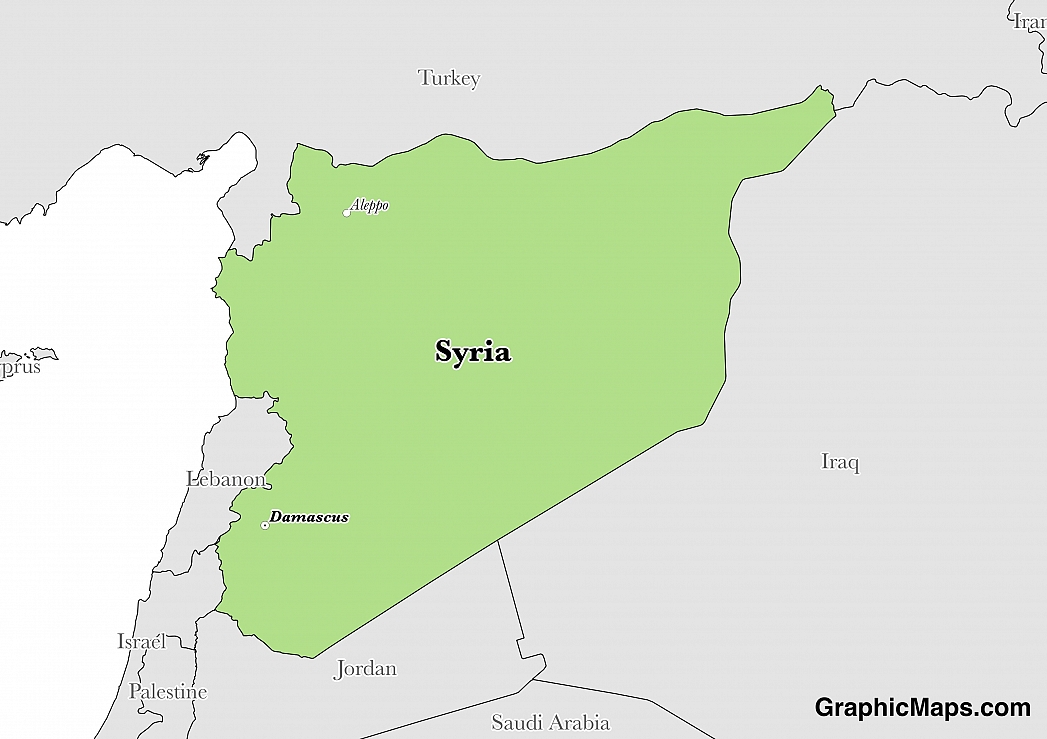Where is Syria?
Located in the Middle East, Syria has a 2,363.00 km border with Iraq (599 km), Israel (83 km), Jordan (379 km), Lebanon (403 km) and Turkey (899 km). It has a 193.00 km coastline. Golan Heights is Israeli-occupied with a UN patrolled buffer zone. Sections of the Syria and Lebanon border are also unclear.
Syria's capital city is Damascus, a city located in the south-western part of the country at the foothills of Anti-Lebanon Mountains. Damascus is part of the greater metropolitan area that is home to five million residents. The city is of great religious and historical importance due to the presence of holy sites and monuments as well as other cultural sites. In 2008, Damascus was named the Arab capital of culture. Since Damascus is located in the desert the temperatures are high reaching 40 degrees Celsius, while coldest temperatures reach -12 degrees Celsius.
Read more on Syria's CapitalSyria is an Asian country covering 185,180.00 km2 of which 0.84% is water and 183,630.00 km2 is land. The includes 1,295 sq km of Israeli-occupied territory. This makes it the 87th largest country in the world and slightly more than 1.5 times the size of Pennsylvania. Its geographic coordinates are 35 00 N, 38 00 E and Damascus is the capital city.
The name comes from the ancient Assyrians, who used to dominate northern Mesopotamia.
Its ISO code is SY.
Geography
Syria has a mean elevation of 514 m above sea level.
It has a tropical climate with a rainy season from June to August. Its terrain is mostly semiarid and arid, with mountains in the west.
Population
Syria has a population of 17,185,170 making it the 65th largest in the world. The highest population density is found along the Mediterranean coast.
Arabic is the official language. The major ethnic group is Arab. The majority of the population identifies as Muslim.
The official language in Syria is Arabic. It is a Central Semitic language and consists of 28 letters of the alphabet. Before the introduction of Arabic into the country in the 7th century, Aramaic was the dominant language. Even though Arabic is the language used in educational institutions, it is not the native language of everyone. The language consists of different dialects spoken in various regions in the country. These dialects are Mesopotamian Arabic, Levantine Arabic, and Bedawi Arabic. 85% of Syrians are Arabic speakers. 9% speaks Kurdish, Armenian is spoken by approximately 1.6%, and 0.3% uses Aramaic language, while 0.1% speaks Domari. Syrian Arabic is written from the right to the left, while Arabic numbers are written from left to right. The minority languages found in Syria are Kurdish which is mainly used by the Kurdish community, Domari is primarily spoken by people from the Dom community, Lomavren used by Lom community, Aramaic, Kabardian, Assyrian, and Armenian.
Read more on Syria's LanguagesThe dialing code for the country is 963.
Government
Syria is an independent country. It gained independence from League of Nations mandate in 1946. Its constitution was last ratified in 2012.
The Arab Republic of Syria has a unitary semi-presidential representative system of government with the head of state is the president, who appoints ministers who works under the Prime Minister. The country has a unicameral parliamentary system with members elected to serve for a period of four years. The political landscape has been dominated for a long time by the Ba áth party, but things changed after the new constitution provided for the multi-party system. With the enactment of the new constitutional order, the president's term has been reduced to a single seven-year term.
Read more on Syria's GovernmentEconomy
Factoring in Purchasing Power Parity, Syria's GDP is $50,280,000,000.00 (USD) with $2,900.00 (USD) per capita. This makes it the 109th largest economy and its citizens the 186th richest in the world. The currency of Syria is the Pound (SYP).
Its major export partners are Iraq, Saudi Arabia, and Kuwait. Its main exports are crude oil, minerals, petroleum products, fruits and vegetables, cotton fiber, and textiles. Its major import partners are Saudi Arabia, the United Arab Emirates, and Iran. Its major imports include machinery, electric power machinery, food, and livestock.
Flag
The Syrian tricolored green-white and black flag with three stars has been used since 1980 when it was officially adopted. The flag is a variant of the independence flag that has since changed over the years but retaining the symbolic colors that represent the three significant Islamic dynasties. The Syrian National Coalition, which controls parts of the country, is using the independence flag. Over time Syria has used several flags during its alliance with other Arab states but retained the basic tricolor design with minor changes to the stars in the middle.
Read more on Syria's FlagThis page was last modified on January 17th, 2018
More on Graphicmaps

Published on 2019-11-06
What is a Trade Embargo?

Published on 2019-11-04
Which Two Countries Used to Have the Same Flag?

Published on 2019-09-16
What Is the Only Two-Sided State Flag?

Published on 2019-09-16
Which Country Flag Looks Like the Texas Flag?

Published on 2019-08-29
Flags That Resemble the US Flag

Published on 2019-08-20
